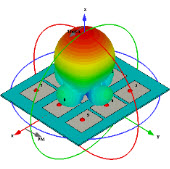请帮帮忙!谢谢了!
05-08
现在有一个实验,小弟真的是无能为力了,各位高人,请帮帮忙,抽空看一下,最好能给我原始电路图的连接方法,万分感激!
The Experiment
1) Investigate λ/4 matching (TL - 50Ω, load will be chosen from the values: 10, 20, 30, 40, 60, 70, 80, 90, 100, 150, 200, 120π Ω).
2) With a load impedance of 32 +j24Ω, implement a design using a λ/8 and λ/4 matching section tomatch to the 50Ω line.
3) With the same load impedance as (3) above use shunt stub matching.
4) Filters
a) Investigate the bandwidth of a simple microstrip stub filter. Compare open circuited and short circuited stubs.
b) The transmission line filter is based on the following properties of a transmission line:
i) A small section of high impedance line is equivalent to a series inductance.
ii) A small section of low impedance line is equivalent to a shunt capacitance
These properties can be shown from:
Zn=Zo (Zl + jZotanβl) ≈ Zo (Zl + jZoβl) (Zo + jZltanβl) (Zo + jZlβl)
a good approximation for βl<π/6 to within 10%.
For high impedance line Zo>>|Zl| say >3|Zl| Then Zn ≈ Zl + jZoβl For TEM this approximates to:
Zn ≈ Zl + jwZol/v :-a SERIES INDUCTANCE
Similarly for Yn with Yo>>Yl we get for low impedance lines :
Yn ≈ Yl + jw Yol/v :- a SHUNT CAPACITANCE
Therefore, cascading these two lines gives a Low Pass filter.
6) Designing a low noise FET amplifier
Use the FET in the device file.
Centre frequency is 6GHz. The optimum source impedance of the FET can be determined by plotting its S11 at 6GHz on the Smith Chart. Determine your design's gain and bandwidth. (Hint: Conjugate matching is just the normal matching technique we use in class. To match a FET that is capacitive we need a matching circuit that is inductive).
The Experiment
1) Investigate λ/4 matching (TL - 50Ω, load will be chosen from the values: 10, 20, 30, 40, 60, 70, 80, 90, 100, 150, 200, 120π Ω).
2) With a load impedance of 32 +j24Ω, implement a design using a λ/8 and λ/4 matching section tomatch to the 50Ω line.
3) With the same load impedance as (3) above use shunt stub matching.
4) Filters
a) Investigate the bandwidth of a simple microstrip stub filter. Compare open circuited and short circuited stubs.
b) The transmission line filter is based on the following properties of a transmission line:
i) A small section of high impedance line is equivalent to a series inductance.
ii) A small section of low impedance line is equivalent to a shunt capacitance
These properties can be shown from:
Zn=Zo (Zl + jZotanβl) ≈ Zo (Zl + jZoβl) (Zo + jZltanβl) (Zo + jZlβl)
a good approximation for βl<π/6 to within 10%.
For high impedance line Zo>>|Zl| say >3|Zl| Then Zn ≈ Zl + jZoβl For TEM this approximates to:
Zn ≈ Zl + jwZol/v :-a SERIES INDUCTANCE
Similarly for Yn with Yo>>Yl we get for low impedance lines :
Yn ≈ Yl + jw Yol/v :- a SHUNT CAPACITANCE
Therefore, cascading these two lines gives a Low Pass filter.
6) Designing a low noise FET amplifier
Use the FET in the device file.
Centre frequency is 6GHz. The optimum source impedance of the FET can be determined by plotting its S11 at 6GHz on the Smith Chart. Determine your design's gain and bandwidth. (Hint: Conjugate matching is just the normal matching technique we use in class. To match a FET that is capacitive we need a matching circuit that is inductive).
相关文章:
射频专业培训教程推荐











